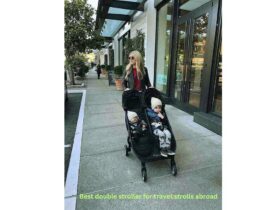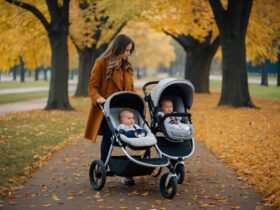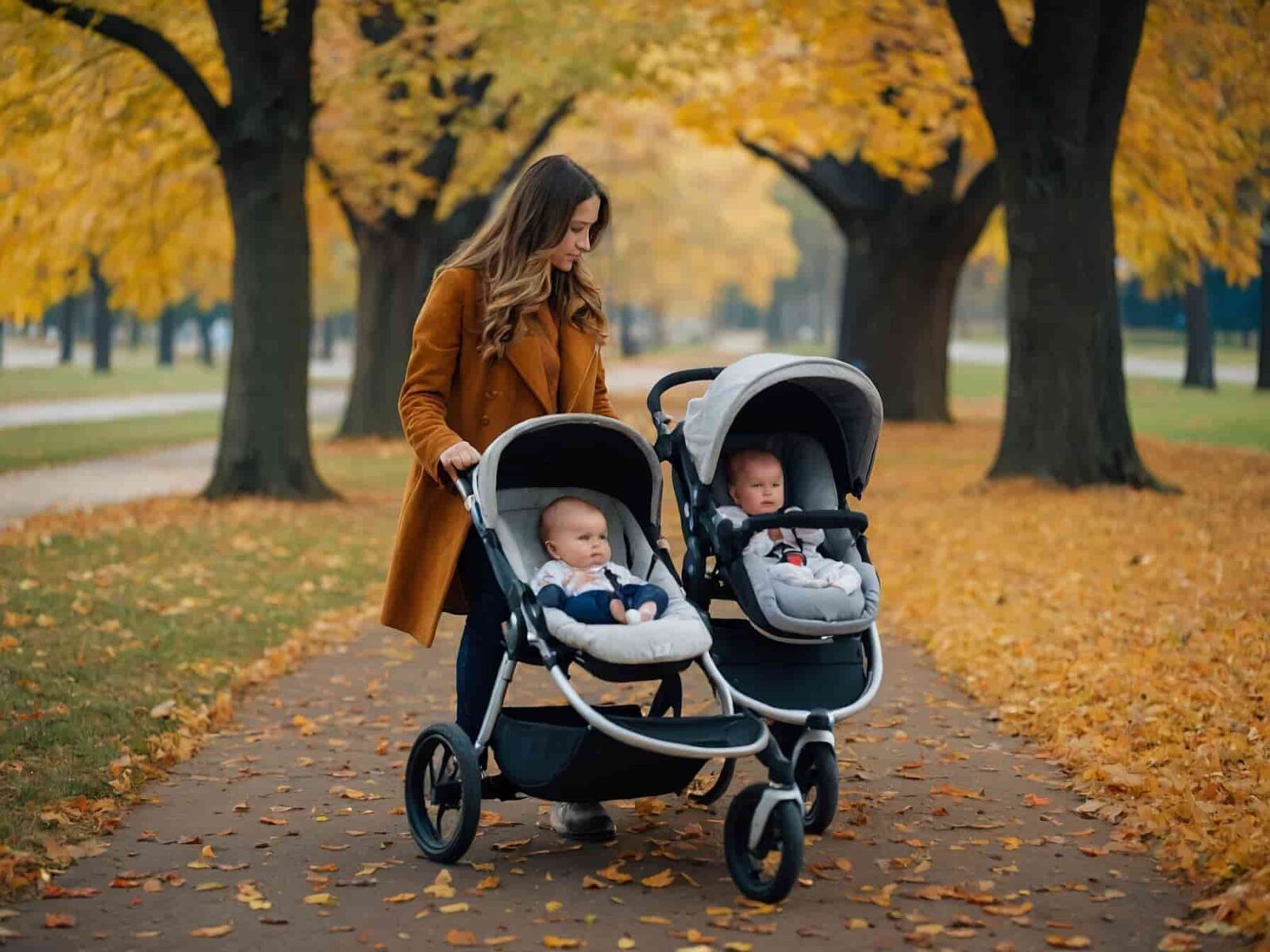A baby can sit in a stroller when they can hold up their head unassisted, typically around 3 to 6 months. Babies must have adequate neck strength for the stroller’s level of recline.
Deciding the right time to transition your baby into a stroller can be a significant step in your little one’s developmental journey. It’s not just about age; it’s about physical abilities. Before you place your baby in a stroller, ensure they have enough control over their head and neck muscles to handle the movement and bumps that come with a stroll.
Parents eagerly anticipate the moment when their child is ready to explore the world from a new vantage point. The key is to look for developmental milestones rather than focusing on a set age. Always check your stroller’s specifications as some models are designed with supports for younger infants, allowing for an earlier introduction to stroller rides. Remember that a secure harness and proper support are crucial when taking your baby out for a jaunt, making those outdoor adventures both safe and enjoyable.
Introduction To Baby’s First Year
The first year of a baby’s life overflows with milestones and memories. As parents eagerly anticipate each new ability their child develops, they often ask, “When can a baby sit in a stroller?” This question is not just about convenience for outings but also about a baby’s physical readiness and safety. Let’s unfold the layers of understanding that come with a baby’s first year and how it relates to using a stroller confidently and safely.
Tracking Developmental Progress
Babies grow at their own pace, and their developmental progress is crucial to determining when they can sit in a stroller. Generally, babies are ready when they can sit upright with minimal support. Typically, this happens between 4 to 7 months. Look for these signs:
- Head control: Baby can hold their head steady without support.
- Trunk control: Developing strength to stay upright with slight assistance.
- Curiosity: Showing an interest in sitting up to see the world.
Importance Of Safety In Early Mobility
Safety is paramount when it comes to transitioning your little one into a stroller. During the first year, babies are vulnerable to sudden movements. It’s important to use a stroller that supports their back and one that comes with secure harnesses to keep them safe. Before placing your baby in a stroller, ensure:
| Feature | Importance |
| Reclining Seat | Allows baby to sit back comfortably until they develop full sitting ability. |
| Five-Point Harness | Keeps the baby secure in the stroller without slipping out or slouching down. |
| Stable Structure | Prevents the stroller from tipping, offering a safe ride for the baby. |
Always start with short periods in the stroller to see how your baby adapts. Enhancing safety in early mobility is a continuous process and requires regular reassessment as your baby grows.
Age Isn’t Just A Number
Age Isn’t Just a Number when anticipating the milestone of a baby sitting in a stroller. It extends beyond mere months to a realm where physical development dictates readiness. Observing a child’s size and strength can help parents identify the ideal time to make this transition, ensuring not only safety but also comfort for their little ones during strolls.
Weight And Height Considerations
The structure of a stroller supports specific weight and height limits. It’s crucial to refer to the manufacturer’s guidance. Adhering to these limits ensures the stroller remains stable and secure as the baby grows. Babies come in all shapes and sizes, so these factors vary for every child.
- Check the stroller’s specifications for weight and height limits.
- Ensure your baby does not exceed these to maintain safety.
- Monitor your baby’s growth and adjust the stroller use accordingly.
Assessing Physical Readiness
Physical readiness plays an integral role in determining if a baby can sit in a stroller. Key indicators include head control and the ability to sit with minimal support. Most babies develop this strength by 6 months, but each child is unique and may reach this stage earlier or later.
Signs that your baby is physically ready for a stroller include:
| Physical Milestone | Importance |
| Steady head control | Indicates neck and upper body strength. |
| Sitting with assistance | Shows developing trunk control. |
| Interest in sitting up | Reflects curiosity and willingness to engage. |
The Milestone Checklist
‘The Milestone Checklist’ is a guide for parents to know when their baby is ready for a stroller. Babies grow quickly, and each milestone is crucial to ensure they can sit safely and comfortably in a stroller. Let’s delve into the specific milestones to look for.
Head Control Mastery
Babies must control their heads before sitting in a stroller. This usually develops around 4 months old. Look for these signs:
- Steady head lifts during tummy time
- No head wobbling when in an upright position
- Turns head side to side without support
Core Strength And Stability
Core strength is key for sitting up in a stroller. By 6 months, most babies start showing signs of this ability:
- Rolling over from tummy to back and back to tummy
- Sitting with little support
- Pushing up to sit from a lying position
Babies with these skills are likely ready to enjoy stroller rides. Always check with your pediatrician if you’re unsure.
Types Of Strollers For Different Development Stages

Navigating the world of baby strollers can feel like charting through a maze of choices. Yet, it all breaks down to finding the right fit for a baby’s growing needs. From newborn nests to toddler-adapted rides, the journey from pram to stroller aligns with each developmental milestone. Understanding the transformation and features of these baby chariots ensures a smooth and secure ride for little ones.
Pram To Stroller Transformation
A pram signifies more than a vintage set of wheels for your bundle of joy. Traditionally designed for newborns who can’t sit up, prams serve as a cozy bed-on-the-go. As infants grow stronger, the need for a more upright seating solution arises. Enter the transformative world of stroller systems.
- Carrycot conversion: Some strollers start as prams and, with a few adjustments, become strollers.
- Seat incline: Many models offer adjustable seats, ready to recline for sleepy infants or elevate for curious toddlers.
- Age recommendation: Typically, transformation happens at around 6 months, when babies can sit with less support.
Features Of An Infant Stroller
Infant strollers are crafted with several key features to protect and comfort babies. At this stage, attention to support and cushioning is essential to keep your little explorer safe.
| Feature | Description |
| Reclining Seat | Allows babies to lie flat or recline as they develop neck and head control. |
| Five-point Harness | Ensures the baby stays secure while strolling, without sacrificing comfort. |
| Canopy | Shields delicate skin from harsh sunlight and provides a cozy, shaded area. |
| Suspension System | Absorbs shocks and smooths out bumpy rides; crucial for a baby’s comfort. |
Opting for a stroller with these features ensures a baby’s journey is as safe as it is joyful, paving the way for years of shared exploration and bonding.
Safety First: Harnessing And Support
As parents, nothing tops the safety of our little ones. Choosing the right time to move a baby to a stroller is critical. Here’s a focus on the importance of a secured and supportive stroller environment. Read on to learn how to protect your bundle of joy while they observe the world from their comfy seat!
Proper Use Of Safety Straps
Always buckle up the baby. Strollers come with safety straps for a reason. They are there to keep the baby safe. Safety straps should not be loose. A snug fit prevents your baby from slipping or falling out. Here are the must-dos:
- Check the buckles every time you place your baby in the stroller.
- Ensure straps go over your baby’s shoulders and around their waist.
- Adjust the fit to match your baby’s size and growth.
Providing Adequate Cushioning And Support
A baby’s stroller seat should provide comfort and support. Stroller cushions protect and support your baby’s back and head. Using the right padding is essential. Here’s what to consider:
- Select soft padding that fits the stroller seat well.
- Ensure head support for infants who can’t hold up their heads.
- Monitor comfort during rides, adjusting padding as needed.
Baby’s Comfort And Enjoyment
Welcome to the world of stroller adventures with your little one! A comfortable and enjoyable ride is key to making the most of your outings. Understanding when a baby can sit in a stroller and how to ensure their comfort and enjoyment is vital.
Adjustable Seating Positions
Strollers with adjustable seating positions offer versatility for your baby’s growth and comfort. The ability to recline is essential for newborns, as they need to lie flat. Toddlers, on the other hand, prefer sitting up to explore the world around them. Look for strollers that provide:
- Multiple recline options
- Supportive straps
- Easy adjustment mechanisms
Ensure a snug fit, so your baby is secure yet cozy during strolls.
Canopy And Storage Considerations
A stroller’s canopy shields your baby from the elements, whether it’s bright sunlight or a sudden drizzle. Features to consider include:
- UV protection
- Adjustable angles
- Peek-a-boo windows
Storage options in a stroller are a boon for parents. Look for:
| Feature | Benefit |
| Large basket | Holds diapers, toys, and snacks |
| Pockets | Keeps essentials within reach |
| Parent tray | Holds drinks and keys |
Choose a stroller that combines practicality with comfort to ensure happy strolls for both of you.
Healthy Posture And Physical Development

Watching your baby grow is exciting. Knowing when they can sit in a stroller is crucial for their wellbeing. As they develop, their ability to hold their head up and manage their body weight matters. A baby’s spine and muscles strengthen over time, allowing them to sit unaided. This milestone usually happens between 4 to 7 months. Let’s explore why a healthy posture and correct physical development are essential for sitting in a stroller.
The Importance Of Back Support
Back support in a stroller safeguards your baby’s posture. Strong back support ensures their spine aligns correctly as they grow. Babies need this foundation for all physical activities. Here are reasons why proper back support is key:
- Spine Health: Keeps the spinal curve natural.
- Comfort: Prevents slouching and ensures comfort during stroller rides.
- Growth: Supports healthy growth and bodily functions.
Avoiding Prolonged Sitting
A baby’s body is not designed for long periods of sitting. Extended sitting can stress their developing spine. Short stroller sessions are best. Here’s what to remember:
- Limited Time: Keep stroller time below 2 hours daily.
- Regular Breaks: Allow your baby to stretch and move frequently.
- Alternate Positions: Switch between sitting and lying down to reduce pressure on the back.
Doctor’s Advice: When To Transition
As a new parent, one of the milestone moments is transitioning your baby to a stroller. Doctors have specific advice on when to make this move. Let’s explore pediatric recommendations and how to spot your baby’s readiness for a stroller adventure.
Pediatrician Check-ups And Recommendations
Regular check-ups with a pediatrician ensure your baby’s growth is on track. These visits are also the perfect time to discuss stroller transition. Your baby’s doctor will assess muscle strength and control. These are critical for sitting in a stroller.
- Neck and Head Control: Babies typically gain control around 4 to 6 months.
- Sitting Assistance: If they can sit with help, it may be time for a reclining stroller.
- Full Sitting: Unassisted sitters can enjoy more upright stroller seats.
Watching For Signs Of Readiness Or Discomfort
Parents can watch for signs that a baby is ready to sit in a stroller. Pay attention to their comfort and safety.
| Signs of Readiness | Indicators of Discomfort |
| Steady head controlCuriosity about surroundingsAttempting to sit up | Slumping or slidingFussiness when seatedLack of interest in sitting up |
Introduce the stroller gradually to ensure your baby feels secure and comfortable.
Adapting To Outdoor Adventures
Embarking on outdoor adventures with a baby brings a wave of excitement and a touch of concern. The anticipation of showing your little one the great outdoors is priceless. Yet, the question remains, when can a baby sit in a stroller and join in on these adventures? Properly equipping a stroller for various landscapes and climate conditions is vital. Let’s explore how to ensure your baby’s comfort and safety as they adjust to the world outside.
Adjusting To Different Terrains
Strolling over diverse terrains means considering the stroller’s features. Look for durable wheels that can handle bumps and shocks.
- Lockable swivel wheels offer stability on rough paths.
- A suspension system ensures a smoother ride.
- Air-filled tires handle various surfaces with ease.
Always engage the lock mechanism on uneven ground to prevent the stroller from rolling away.
Managing Sun Exposure And Weather Conditions
Shielding your baby from the elements is critical for a pleasant outdoor experience. Whether under the sun or facing a breeze, proper preparation is key.
| Condition | Protection |
| Sun | UV-protective canopy, sun hat |
| Wind | Wind-resistant cover |
| Rain | Waterproof shield |
Remember to dress your baby appropriately for the weather. Layering allows for quick adjustments to changing temperatures.
Common Questions From Parents
Parents often ask when their baby can sit in a stroller. Steps for baby growth are exciting. Each stage brings a bunch of joy and questions. Parents want the best for their babies during strolls. Here’s a look at common concerns parents have about stroller usage.
Navigating Public Spaces With Strollers
Public spaces can challenge new parents. Moving around with a stroller demands skill and care. Here’s how to know if your baby is ready:
- A baby can sit in a stroller by 4 to 6 months old.
- Look for head control. Babies must hold their heads up.
- Reclining strollers help with gradual sitting.
- Shopping trips and walks require a sturdy stroller.
- Always remember to use safety harnesses.
When To Upgrade To A Larger Stroller
Babies grow quickly. A larger stroller may be needed. Signs to upgrade:
| Sign | Explanation |
| Tight Fit | If your baby seems cramped, it’s time. |
| Discomfort | A fussy baby might need more space. |
| Stroller Wear | Worn out strollers must be replaced for safety. |
| Weight Limit | Exceeding limits means you need a bigger stroller. |
Frequently Asked Questions Of When Can A Baby Sit In A Stroller?
When Can You Put A Baby In Stroller Without Car Seat?
A baby can usually ride in a stroller without a car seat from around 6 months old, when they can sit up unassisted. Always check the stroller’s manual for specific recommendations.
Can A 3 Month Old Sit Up In A Stroller?
A 3-month-old may not have the neck strength to sit up in a stroller safely. Always ensure the stroller has a reclined position suitable for infants.
When Can Babies Sit Forward In Stroller?
Babies can usually sit forward in a stroller at around 6 months old, when they can sit up unaided and have stable head control. Always check the stroller’s instructions for specific recommendations.
Can I Put My 4 Month Old In A Stroller?
Yes, you can put your 4-month-old in a stroller if it reclines to a near-flat position. Always ensure the baby is securely strapped in and the stroller is suitable for their age.
What Age Can Babies Start Stroller Rides?
Most babies are ready for stroller rides at 4-6 months when they have developed sufficient head and neck control.
Conclusion
Determining the right time for your baby to graduate to a stroller is essential. Tailor this transition to your child’s individual growth and comfort levels. Use this guide to make informed decisions, and embrace this new stage. Remember, each child’s development is unique, and safety should always come first.












Leave a Review